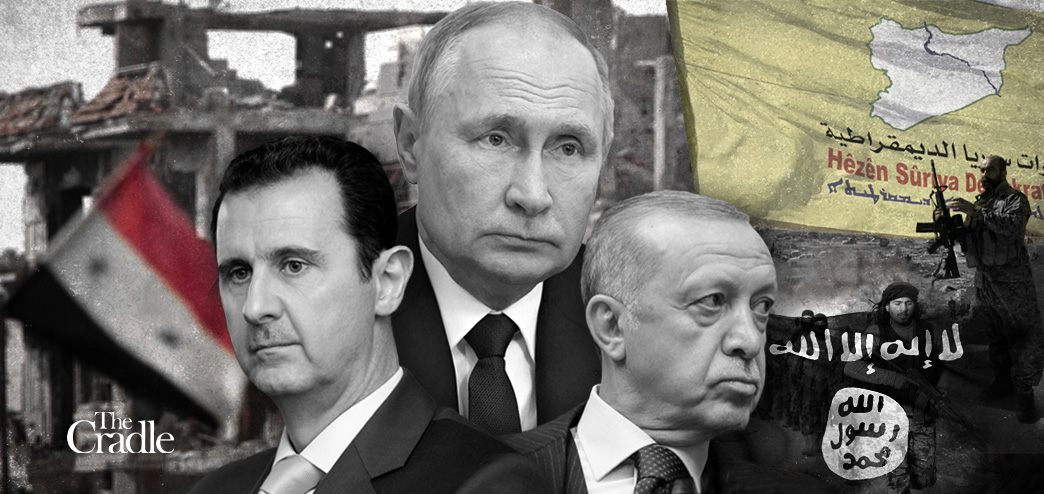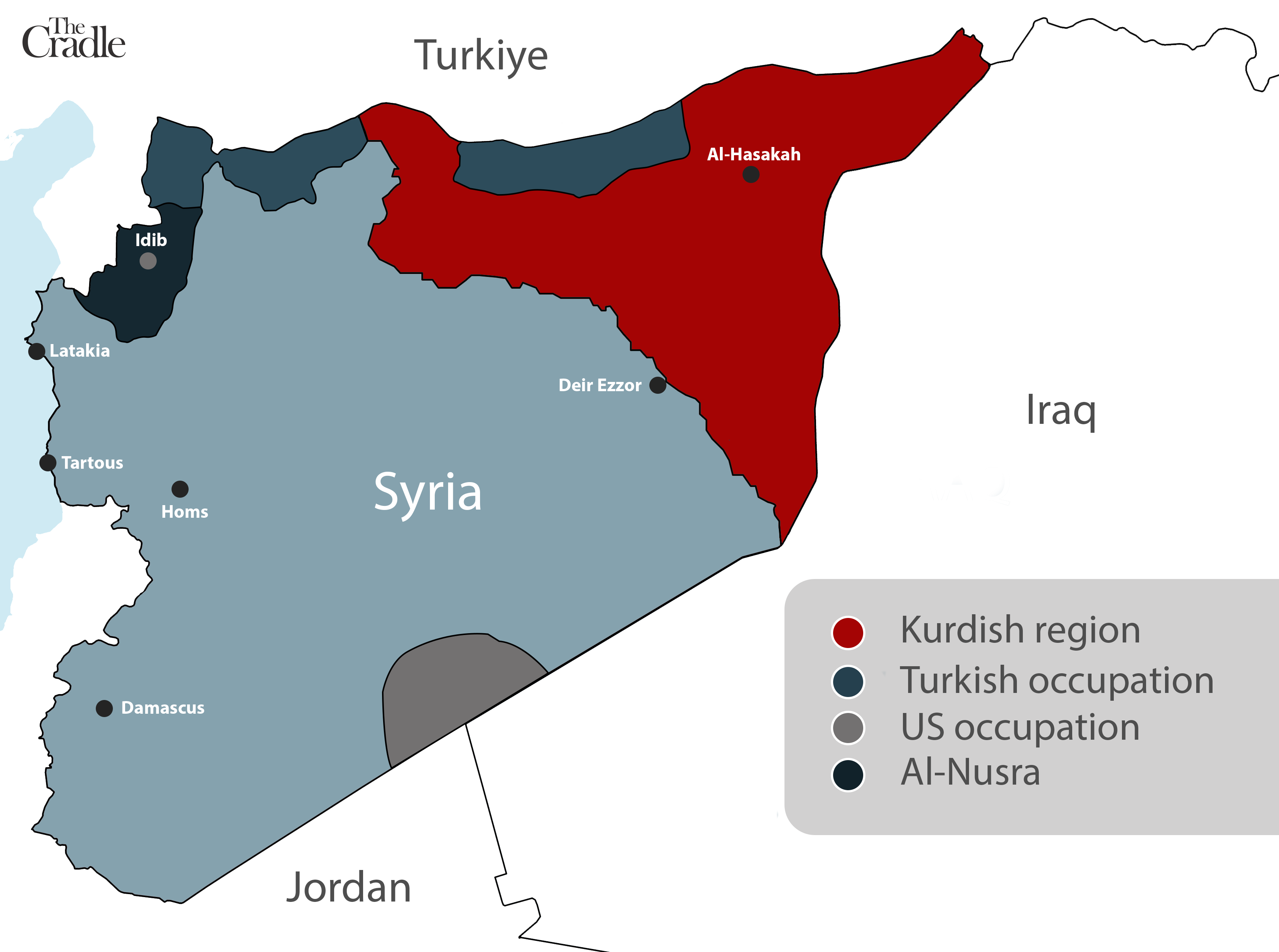Russian-brokered Syrian-Turkish rapprochement will bury prospects of a divided Syria, with the potential for opposition factions to be co-opted into the armed forces.

The newly-initiated Syrian-Turkish rapprochement talks are headed in Damascus’ favor and the “Turkish concessions” derided by opponents are just the start, insiders tell The Cradle.
Turkish President Recep Tayyip Erdogan has already abandoned his dream of “praying in the Umayyad Mosque” in Damascus. But sources say this will be swiftly followed by further concessions that will throw a wrench into the ambitions of Syria’s opposition factions.
An undivided Syria
There will be no “federalism” or “confederation” – western codewords for the break up of the Syrian state – at these talks, but rather a “Turkish-Russian” acceptance of Damascus’ conditions.
For starters, Ankara plans to open the strategic M4 highway – which runs parallel to the Turkish border and connects all the vital Syrian cities and regions – as a prelude to opening the legal border crossings between Syria and Turkiye, which will re-establish trade routes between the two countries.
This move, based on an understanding between Damascus and Ankara, will essentially close the door on any opposition fantasies of breaking Syria into statelets, and will undermine the “Kurdish-American divisive ambition.”
It is not for nothing that Washington has sought to thwart communications between Ankara and Damascus.
Under the guise of “fighting ISIS,” the US invested heavily in Syrian separatism, replacing the terror group with “Kurdish local forces” and reaped the rewards in barrels of stolen Syrian oil to help mitigate the global energy crisis.
Now Turkiye has closed the door to that ‘federalization’ plan.
A Russian-backed proposal
The Syrian-Turkish talks in Moscow on 28 December focused mainly on opening and establishing the necessary political, security, and diplomatic channels – a process initiated by their respective defense ministers.
While resolving the myriad thorny files between the two states is not as easy as the optimists would like, it is also nowhere as difficult as the fierce opponents of rapprochement try to suggest.
The Moscow discussions centered on mild, incremental solutions proposed by Russia.
The Kremlin understands that the minefield between Ankara and Damascus needs to be dismantled with cold minds and hands, but insists that the starting point of talks is based on the political formulas of the Astana peace process that all parties have already accepted.
On the ground, Moscow is busy marketing satisfactory security settlements for all, though those on the battlefield appear to be the least flexible so far.
The Russian plan is to “present security formulas to the military,” intended to be later translated into the integration of forces – whether Kurdish fighters or opposition militants – into the ranks of the Syrian Arab Army (SAA).
This will be achieved via committees led by both Syrian and Turkish intelligence services, a Russian source involved in coordinating the talks tells The Cradle.

Co-opting the Kurds
The Russian proposals, according to the source, rely on two past successful models for reconciliation on the battlefield.
The first is the “Sheikh Maqsoud neighborhood model in northern Aleppo,” an area once controlled by Kurdish forces who began to coordinate with the SAA after the sweeping 2016 military operation that expelled opposition militants from the eastern neighborhoods of the city.
The Russian source says that the “Sheikh Maqsoud” model succeeded because of “security coordination,” revealing that “Syrian state security is deployed at the entrances to the neighborhood with checkpoints that coordinate with the Kurdish forces inside – in every way, big and small.”
This security coordination includes “arresting criminally wanted persons, and facilitating administrative and service services” in coordination with Damascus.
The second reconciliation model used by Russian forces in Syria succeeded in bringing together the SAA and Sheikh Maqsoud Kurdish militias in a joint military maneuver conducted near the town of Manbij in the countryside of Aleppo last August.
While the Russian source confirms that the experience of “security coordination” between the SAA and the Kurdish forces was “successful,” he cautions that these models need “political arrangements” which can only be achieved by “an agreement in Astana on new provisions to the Syrian constitution, which give Kurds more flexibility in self-governance in their areas.”
Opposition amnesty
A parallel proposal revealed to The Cradle by a Turkish source, approaches ground solutions from a “confederation” angle, anathema to the Syrian authorities. According to him, “Damascus must be convinced of sharing power with the qualified factions of the (Turkish) National Army for that.”
While the Turkish proposal tried to move a step closer to Damascus’ aims, it seems that Russian mediation contributed to producing a new paradigm: This would be based on the tried-and-tested Syrian “military reconciliation” model used for years – namely, that opposition militants hand over their arms, denounce hostility to the state, and are integrated into the SAA.
Turkiye’s abandonment of its “demand to overthrow the regime” applies also to its affiliated military factions inside Syria, as the latter’s goals have dwindled to preserving some areas of influence in the north of the country.
This is the current flavor of Turkiye’s reduced “confederation” ambitions: To maintain Turkish-backed factions within “local administrations” in northern areas where Turkiye has influence.
This, in return for giving up on Ankara’s political ambition of “regime change” in Damascus and redrawing Syria’s northern map. The solution here will require amending the Syrian constitution, a process that began several years ago to no avail.
From the Syrian perspective, officials are focused on eliminating all opposing separatist or terrorist elements who do not have the ability to adapt to a “unified” Syrian society.
Therefore, Damascus rejects military reconciliation proposals for any “sectarian” separatist or factional militias. Syrian officials reiterate that “the unity of the lands and the people” is the only gateway to a solution, away from the foreign interests that promote “terrorism or secession” – a reference to the Turkish and American role in Syria’s war.
Reconciliation on Damascus’ terms
There is no “confederation” in the dictionary of the Syrian state, and it is determined to stick hard to the principle of Syrian unity until the end. Damascus is intent on one goal: Reconciliations based on surrendering arms in the countryside of Latakia, Idlib, Aleppo, Raqqa, Hasakah, Qamishli, and al-Tanf, which are the areas that are still outside the control of the state.
According to the Turkish source, Syria refused to discuss anything “outside the framework of reconciliations and handing over weapons and regions,” which he says “makes it difficult for Ankara to undertake its mission,” especially in light of the fact that the Al Qaeda-affiliated Nusra Front controls large parts of these target areas.
A Syrian source tells The Cradle that the “Qamishli model” of military reconciliation is the closest one that applies to this case: Wherein “the SAA and national defense forces (the majority of which are pro-Damascus Kurds) coordinate fully.”
He makes clear that Damascus has already provided ample self-governance mechanisms for Kurds in the country’s north:
“The (Kurdish-run) Autonomous Administration in Syria already exists. It deals directly with Syria’s Ministry of Local Administration (in Damascus) and has multiple agencies that work through local representative councils to implement government plans in terms of security, tax collection, and services,” and of course it consists of the people of the region – Kurds.
The recent statement of top Erdogan advisor Yassin Aktay may throw a wrench in those works. His insistence that Turkiye should maintain control over the city of Aleppo – Syria’s second most populous, and its industrial heart – did not come out of nowhere.
Ankara considers that its repatriation of three million Syrian refugees should start from “local administrations run by the (Turkish-backed) Syrian National Army (a rebranded version of the opposition ‘Free Syrian Army),” says the Turkish source.
He is referring to Idlib, Aleppo, and their countrysides, and the areas in which Turkiye launched its “Olive Branch” and “Euphrates Shield” military operations. These locales in Syria’s north include the northern and eastern countryside of Aleppo, including Azaz, Jarabulus, al-Bab, Afrin, and its environs.
Turkiye may consider gradually handing over these strategic zones to its allied Syrian militias, he says.
“Call it confederation or not, these areas should be controlled by the Syrian National Army factions instead of the Al-Nusra Front – in order to ensure the safe return of the refugees.”
Steady progress
In short, the Russian mediation to bring Damascus and Ankara closer is moving slowly, but according to the Turkish source, “it is closer to reconciliation because the Syrian Ministry of Local Administration is beginning to take charge of regional affairs after holding new local council elections – in compliance with plans forged in the Astana process.”
Regarding Astana, the Turkish source says, “Let the Syrians treat the Kurdish and opposition areas as one, if the Kurds agree to dismantle their factions and join the Syrian army within a certain equation, the opposition factions will also accept.”
Regarding the complicated geopolitics of Syria’s east – currently occupied by US troops and their proxies – a high-ranking Syrian official who recently visited Saudi Arabia and Cairo, proposed “Arab intervention with the Syrian tribes to disengage tribe members in the Al-Tanf region from the US forces.”
But according to the official, this would be subject to “the progress of relations between Damascus, Riyadh, Cairo, and possibly even Jordan.”
A few days ago, a video message was sent by Nusra Front leader Abu Muhammad al-Julani, in which he thundered: “Where are the armies of the Muslims?”
It is a topical message from Al Qaeda’s Syria boss, who is angling to maintain his sectarian “area of influence” in northwest Syria – strategic Idlib on the Turkish-Syrian border.
Julani’s destructive narrative may be the last barrier to break for Damascus, Ankara, and Moscow to strike a deal on the ground.
By Malek al-Khoury
Published by The Cradle
Republished by The 21st Century
The views expressed in this article are solely those of the author and do not necessarily reflect the opinions of 21cir.com
